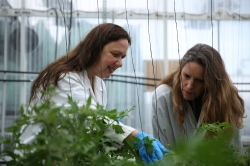Should Patriots be willing to move No. 34 pick in deal to land stud WR? originally appeared on NBC Sports Boston
We’re a little less than a month into NFL free agency and the New England Patriots still don’t have a legitimate No. 1 wide receiver on their roster.
They reportedly made a competitive offer to free agent Calvin Ridley, but he chose to sign for more money with the Tennessee Titans. The Patriots did re-sign Kendrick Bourne and added former Vikings wideout K.J. Osborn, which are both good moves, but neither player is an elite playmaker at the position.
The trade market is now the best place for the Patriots to find that stud wide receiver they’ve lacked for a long time. And the Patriots have the salary cap space — a league-high $47 million, as of Thursday — to make that kind of upgrade and still have plenty of money left over to sign their rookie class.
🔊 Patriots Talk Podcast: How motivated are Patriots to swing a big WR trade? What’s Washington thinking at No. 2? | Listen & Subscribe | Watch on YouTube
One of the most valuable trade chips the Patriots own is the No. 34 overall pick in the 2024 NFL Draft. It’s the second pick in the second round. Should they be willing to include that pick as part of a package to acquire a star wideout?
“Because free agency went the way it did for the Patriots, right now I would say yes,” Phil Perry explained on a new episode of NBC Sports Boston’s Patriots Talk Podcast. “Initially, before really getting into this offseason, I believed they should figure out a way to give the guy who ended up in Tennessee (Ridley) all that money. Give him whatever he needs to come to New England, and then you’ve got so much wiggle room in the draft. You can use the second-round pick on a receiver, because you need another one, probably. You can use one on an offensive tackle. You can go in all sorts of ways.
“But free agency didn’t go that way, so now I would say yes. Would I trade No. 34 overall for Brandon Aiyuk and give him a boatload of money? I sure would. At this point in time, I would.”
Which players could the Patriots potentially consider pursuing on the trade market? There’s one specific area Perry would explore first if he was the general manager.
“Where I start are the players who are going to be free agents next year as teams start to anticipate who they are going to pay or not in 2025 and beyond,” Perry said. “So you have to start at the top of the list with Tee Higgins. He’s on the franchise tag, a true X boundary receiver. You know what you’re getting there.
“But that free agent class for next year, guys with one year left on their deals, is absolutely loaded. It’s Tee Higgins, Keenan Allen, Chris Godwin, Amari Cooper, Diontae Johnson, DeAndre Hopkins if he’s still good. Ja’Marr Chase is scheduled to be a free agent, although I believe the Bengals will lock him up. Jaylen Waddle, does he shake free because the Dolphins decided to pay Tua Tagovailoa and Tyreek Hill and not Tyreek and Waddle? DeVonta Smith, CeeDee Lamb, Justin Jefferson.
“It’s a ridiculous list of receivers that are scheduled to be, at this point in time, free agents next offseason. Those would be the kinds of calls that I would be trying to make right now. I might take Diontae Johnson off that list. I’d take DeAndre Hopkins off that list. But if you could figure something out with Tee Higgins, Chris Godwin, CeeDee Lamb, Justin Jefferson — that’s the kind of major swing that I would be attempting at this time if I’m New England.”
It’s fair to assume not all of these players will get to free agency, especially given how important it is in the modern NFL to have an elite wideout. But the Patriots should at least pick up the phone and give some of these teams a call.
The Patriots could get a pretty good wideout with the No. 34 overall pick, or they could trade the selection for a veteran who’s already a really productive player. That’s one of the debates the Patriots front office needs to have as the 2024 NFL Draft approaches.
Also in this episode:
-
Reaction to the Stefon Diggs trade
-
What would it take for the Patriots to trade down in the draft?
-
J.P. Finlay on who Washington may target at No. 2 overall
-
Joe Person on the character of Drake Maye














